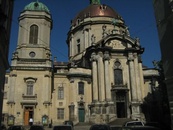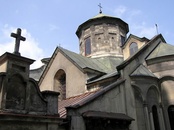| Collegiate Church of St. Onuphrius
Another temple of Lvov princely era is the monastic church of St. Onuphrius. Together with Svyatonikolaevskoy it is mentioned in the oldest Lviv acts. It is likely that the first wooden church, in which the monks had settled, was here during the time of Prince Lev Danilovich. According to legend, the monastery was stored image of the Mother of God, drawn by St. Luke in the cypress board. Kostyantin emperor transferred the image to its capital, and from Constantinople, he, along with the Byzantine princess Anna came to Kiev. After three hundred years, the icon went to Prince Leo, who passed it on to the Basilian monastery. After some time, brought it to Belz, and then - in 1377 at Clear Mountain to Czestochowa in Poland. There, she became famous chudami. Today the old Princely image of Our Lady of Czestochowa regarded as the biggest shrine in Poland. |  |
| Church of St. John the Baptist
(The museum of ancient monuments in Lviv) Historians disagree on exactly when it was built one of the most ancient temples of the city. According to the first version, it was built in 1201 in honor of the birth of Danylo Galitsky. In 1230-ies. It stayed in the Dominican monks, and in 1240 the 50-ies. - It gave fervent Catholic Constantia - daughter of Hungarian King Bella IV, his wife Lev. After her death the shrine moved to the Armenians, Uniates. According to the second version, the temple was built by the monks, the Dominicans in 1260 or in 1270 by order of Prince Lev is for Constance. He later moved to the Armenians. A third version, in 1270 P. church was built for themselves Armenians. But he soon became a relic of Catholics. But probably none of these dates are not reliable. The results of studies of the modern church Murowana conducted in 1984-1985. Does not give any reason to date him XIII century. Discovered architectural details indicate that it was built no earlier than the middle - second half of XIV century. |  |
| The ensemble of the Assumption Church
Obrazets perfection of Renaissance architecture in Lviv - the ensemble of the Assumption tserkvi.Prohodya in Lviv on Russian streets, with the left hand struck a splendid architectural structure with a green dome - the pearl of Renaissance architecture of the city. |  |
| Dominican Church
The foundation stone of this majestic structure laid Jozef Potocki, Great Crown Hetman, who was the principal, as they say, an investor in the construction, which lasted from 1749 to 1764. |  |
| Church of St. Anthony
Church of St. Anthony, located on a bend of the street Lychakivska, among the monuments in Lviv are exquisitely forms and at the same time, a special delicacy. This church is a kind of boundary that divides the street into halves - the lower and upper Lychakov. |  |
| Church of the Holy Apostles Peter and Paul
In Lviv attractions include the Orthodox Church of St. Peter and St. Paul in the street Lychakivska, 82-a. It was built in 1668 and initially served as a chapel. In 1762 the church became a temple of a religious order Paulino, who in 1782 built and dedicated the new church. |  |
| Archcathedral St. George
Lviv attractions - is primarily the Cathedral of St. George, one of the most remarkable works of art not only in Ukraine but throughout Europe, the jewel of Ukrainian late baroque architecture. |  |
| Church of the Holy Virgin Protection
Lviv - the city of temples. One of them - the former church of St. Nicholas, and now - a temple of the Holy Virgin Protection - situated on a hill on the street, Grushevskiy 5. It was built in 1739-1745, respectively, and until 1785 belonged to the monastic order Trinitarian. |  |
| Cathedral of the Assumption of the Blessed Virgin Mary
The only Gothic landmark is the ancient city of Lviv Cathedral of the Assumption of the Blessed Virgin Mary, founded in 1360, designed by architect Peter Shtehera. His first master builder was Lviv Nicholas Nitschke, and the foundation stone shrine was founded by Polish King Casimir the Great. and the first stone. |  |
| Armenian Cathedral of the Assumption of the Blessed Virgin Mary
History of Lviv - a story of people of different nationalities. Center of the revival of religious and cultural life of Armenians in Lviv and Ukraine is the Armenian Church (Armenian Street, 7), built in 1363 by architect Doring (Dore, Dork). |  |
| Church of St. Elisabeth
Neo-Gothic Cathedral in Lviv, in the area Kropivnitskogo, just off Gorodotska. According to legend the church was named after popular among the people of Empress Elizabeth (Zizi), Habsburg, wife of the Austro-Hungarian emperor Franz Joseph I. Erected in 1903-1911, respectively. Construction led the architect K. Talevsky. Imitative neo-Gothic style cathedral repeats many of the elements of French and North German Gothic architecture with elements of the Romanesque style: the high peaked steeples, lancet windows, a large portal with a rose in the center, the inner vertical space. Since 1991, is owned by the Ukrainian Greek Catholic Church and called the church of St Olga and Elizabeth. |  |








